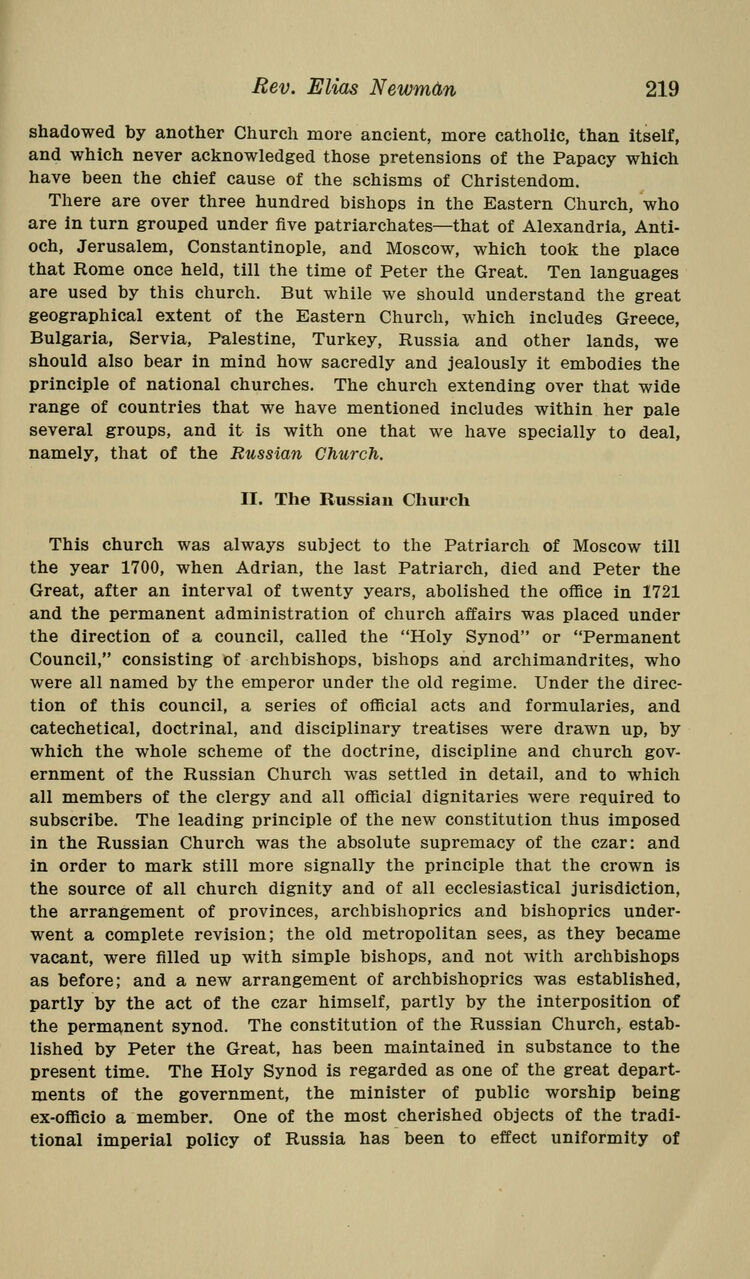
Full resolution (JPEG) - On this page / på denna sida - Russia and the Greek Church. The Rev. Elias Newman - I. The Greek Church—Its Peculiarities - II. The Russian Church

<< prev. page << föreg. sida << >> nästa sida >> next page >>
Below is the raw OCR text
from the above scanned image.
Do you see an error? Proofread the page now!
Här nedan syns maskintolkade texten från faksimilbilden ovan.
Ser du något fel? Korrekturläs sidan nu!
This page has never been proofread. / Denna sida har aldrig korrekturlästs.
Rev, Elias Newmdn 219
shadowed by another Church more ancient, more catholic, than itself,
and which never acknowledged those pretensions of the Papacy which
have been the chief cause of the schisms of Christendom.
There are over three hundred bishops in the Eastern Church, who
are in turn grouped under five patriarchates—that of Alexandria, Anti-
och, Jerusalem, Constantinople, and Moscow, which took the place
that Rome once held, till the time of Peter the Great. Ten languages
are used by this church. But while we should understand the great
geographical extent of the Eastern Church, which includes Greece,
Bulgaria, Servia, Palestine, Turkey, Russia and other lands, we
should also bear in mind how sacredly and jealously it embodies the
principle of national churches. The church extending over that wide
range of countries that we have mentioned includes within her pale
several groups, and it is with one that we have specially to deal,
namely, that of the Russian Church.
II. The Russian Church
This church was always subject to the Patriarch of Moscow till
the year 1700, when Adrian, the last Patriarch, died and Peter the
Great, after an interval of twenty years, abolished the office in 1721
and the permanent administration of church affairs was placed under
the direction of a council, called the "Holy Synod" or "Permanent
Council," consisting of archbishops, bishops and archimandrites, who
were all named by the emperor under the old regime. Under the direc-
tion of this council, a series of official acts and formularies, and
catechetical, doctrinal, and disciplinary treatises were drawn up, by
which the whole scheme of the doctrine, discipline and church gov-
ernment of the Russian Church was settled in detail, and to which
all members of the clergy and all official dignitaries were required to
subscribe. The leading principle of the new constitution thus imposed
in the Russian Church was the absolute supremacy of the czar: and
in order to mark still more signally the principle that the crown is
the source of all church dignity and of all ecclesiastical jurisdiction,
the arrangement of provinces, archbishoprics and bishoprics under-
went a complete revision; the old metropolitan sees, as they became
vacant, were filled up with simple bishops, and not with archbishops
as before; and a new arrangement of archbishoprics was established,
partly by the act of the czar himself, partly by the interposition of
the permanent synod. The constitution of the Russian Church, estab-
lished by Peter the Great, has been maintained in substance to the
present time. The Holy Synod is regarded as one of the great depart-
ments of the government, the minister of public worship being
ex-officio a member. One of the most cherished objects of the tradi-
tional imperial policy of Russia has been to effect uniformity of
<< prev. page << föreg. sida << >> nästa sida >> next page >>